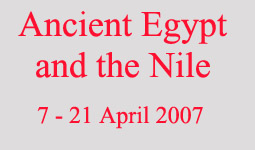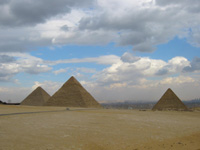Page 1 2 3 4 5 6 7 8 9 10 11 12 13 14 15 16 17 18 19 [History]
Saturday, 14 April. We were up at 5:30 on a
beautiful morning. From our cabin we could see the hot air balloons carrying
some of our shipmates over the Valley of the Kings across the river. We had
decided not to take this optional tour ($145) primarily because of the 3:00 wake
up time, but also because we thought it might be difficult for Jane to get in
and out of the gondola.
We had breakfast at 6:00 and were on the bus before 7:00 for the tour to the Valley of the Kings. Although the Anuket was moored directly across the Nile from the Valley, the bus had to drive some distance along the east bank before there was a bridge. We got to the Valley about 7:30. Salah explained that, beginning with Thutmose I (18th Dynasty, New Kingdom), the practice of burying the pharaohs in pyramids in the Memphis area (near Cairo) was abandoned because such tombs inevitably were robbed. Instead, the tombs of subsequent pharaohs were built in this valley at Thebes (Luxor), cut deep into the limestone on the mistaken premise that they would be easier to conceal and harder to rob. Then we boarded the shuttle trains that took us into the heart of the site. Salah gave us each an admission ticket that allowed us to visit any three of the tombs that were open. To limit damage from too many visitors, access is rotated and only a small number of tombs are open at one time. Unfortunately, Tutankhamun's tomb was not one of those open today.
Our first visit was to the tomb of Ramses I (1295-1294). It was probably a poor choice because we had to descend a very long, steep stairway and found only one small chamber at the bottom. However, that chamber was elaborately decorated. Only later did we learn that Ramses I died suddenly and his tomb was hastily prepared.
Next we visited the tomb of Ramses IX (1126-1108 B.C. We descended a long staircase with heavily decorated walls. We continued through a long series of corridors (probably about 200 feet in all), also well decorated, with a couple small chambers on either side, followed by more corridors, and finally reached a small burial chamber with a pit in the floor.
In the case of all three of these tombs, and undoubtedly the many others we didn't see, it's hard to imagine the labor it took to carve them out of solid limestone, not to mention the elaborate decorations. We were told that, on the average, it took six years to prepare such a tomb. An enormous amount of debris was created in the process, too. Most of it was simply left on the ground around the tomb. In fact, that's the main reason Tutankhamun's tomb escaped the grave robbers. The tomb of a later pharaoh was built higher on the hill above his, and the debris from that tomb covered the entrance to Tutankhamun's. We took the little train back to the entrance and found our bus. At 9:45 it took us a short distance to an alabaster shop, one of several grouped together. After 40 minutes there, the bus took us to the Valley of the Queens, burial place not only of pharaohs' wives, but also of their children and other nobles. It was a long walk in the hot sun from the bus to the tombs. Probably the most interesting tomb there, that of Nefertari (favorite wife of Ramses II), was closed for repairs. We went into two tombs: those of Amen-Khopshef (son of Rameses III) and Queen Titi (wife of Amhenhotep III). We were on our way again by 11:30, happy to be on the air conditioned bus. The bus made a brief photo stop at the Colossi of Memnon, actually two massive stone statues of Pharaoh Amenhotep III, but renamed by the Greeks. The statues originally guarded the entrance to a gigantic temple, very little of which remains.
Page 1 2 3 4 5 6 7 8 9 10 11 12 13 14 15 16 17 18 19 [History]
Copyright © 2000-2023 DarrellPeck.com All rights
reserved. | ||||||||||










